Tribological Properties of Nano-Scale Al2O3 Particles with Different Shapes as Lubricating Oil Additives
Abstract
:1. Introduction
2. Experimental Methods
2.1. Preparation of Al2O3 Nanoparticles
2.2. Tribological Test
3. Results and Discussion
3.1. Effects of Nanoparticle Shape and Concentration on Coefficient of Friction
3.2. Effects of Nanoparticle Shape and Concentration on the Wear of Block Surfaces
3.3. Possible Lubrication Mechanism of Al2O3 Nanoparticle Additives
4. Conclusions
Author Contributions
Funding
Institutional Review Board Statement
Informed Consent Statement
Data Availability Statement
Acknowledgments
Conflicts of Interest
References
- Livanos, G.A.; Kyrtatos, N.P. Friction model of a marine diesel engine piston assembly. Tribol. Int. 2007, 40, 1441–1453. [Google Scholar] [CrossRef]
- Li, R.; Wen, C.; Meng, X.; Xie, Y. Measurement of the friction force of sliding friction pairs in low-speed marine diesel engines and comparison with numerical simulation. Appl. Ocean. Res. 2022, 121, 103089. [Google Scholar] [CrossRef]
- Higgs III, C.F.; Wornyoh, E.Y.A. An in situ mechanism for self-replenishing powder transfer films: Experiments and modeling. Wear 2008, 264, 131–138. [Google Scholar] [CrossRef]
- Yu, Y.; Gu, J.; Kang, F.; Kong, X.; Mo, W. Surface restoration induced by lubricant additive of natural minerals. Appl. Surf. Sci. 2007, 253, 7549–7553. [Google Scholar] [CrossRef]
- Zhang, B.S.; Xu, B.S.; Xu, Y.; Gao, F.; Shi, P.J.; Wu, Y.X. Cu nanoparticles effect on the tribological properties of hydrosilicate powders as lubricant additive for steel–steel contacts. Tribol. Int. 2011, 44, 878–886. [Google Scholar] [CrossRef]
- Padgurskas, J.; Rukuiza, R.; Prosyčevas, I.; Kreivaitis, R. Tribological properties of lubricant additives of Fe, Cu and Co nanoparticles. Tribol. Int. 2013, 60, 224–232. [Google Scholar] [CrossRef]
- Wu, Y.Y.; Tsui, W.C.; Liu, T.C. Experimental analysis of tribological properties of lubricating oils with nanoparticle additives. Wear 2007, 262, 819–825. [Google Scholar] [CrossRef]
- Zhou, J.; Yang, J.; Zhang, Z.; Liu, W.; Xue, Q. Study on the structure and tribological properties of surface-modified Cu nanoparticles. Mater. Res. Bull. 1999, 34, 1361–1367. [Google Scholar] [CrossRef]
- Zhou, J.; Wu, Z.; Zhang, Z.; Liu, W.; Xue, Q. Tribological behavior and lubricating mechanism of Cu nanoparticles in oil. Tribol. Lett. 2000, 8, 213–218. [Google Scholar] [CrossRef]
- Li, B.; Wang, X.; Liu, W.; Xue, Q. Tribochemistry and antiwear mechanism of organic–inorganic nanoparticles as lubricant additives. Tribol. Lett. 2006, 22, 79–84. [Google Scholar] [CrossRef]
- Sun, L.; Zhang, Z.J.; Wu, Z.S.; Dang, H.X. Synthesis and characterization of DDP coated Ag nanoparticles. Mater. Sci. Eng. A 2004, 379, 378–383. [Google Scholar] [CrossRef]
- Abdullah, M.I.H.C.; Abdollah, M.F.B.; Tamaldin, N.; Amiruddin, H.; Nuri, N.R.M. Effect of hexagonal boron nitride nanoparticles as an additive on the extreme pressure properties of engine oil. Ind. Lubr. Tribol. 2016, 68, 441–445. [Google Scholar] [CrossRef]
- Li, H.; Zhang, Y.; Li, C.; Zhou, Z.; Nie, X.; Chen, Y.; Sharma, S. Extreme pressure and antiwear additives for lubricant: Academic insights and perspectives. Int. J. Adv. Manuf. Technol. 2022, 120, 1–27. [Google Scholar] [CrossRef]
- Zhao, J.; Huang, Y.; He, Y.; Shi, Y. Nanolubricant additives: A review. Friction 2021, 9, 891–917. [Google Scholar] [CrossRef]
- Tan, W.K.; Hakiri, N.; Yokoi, A.; Kawamura, G.; Matsuda, A.; Muto, H. Controlled microstructure and mechanical properties of Al2O3-based nanocarbon composites fabricated by electrostatic assembly method. Nanoscale Res. Lett. 2019, 14, 245. [Google Scholar] [CrossRef]
- Luo, T.; Wei, X.; Huang, X.; Huang, L.; Yang, F. Tribological properties of Al2O3 nanoparticles as lubricating oil additives. Ceram. Int. 2014, 40, 7143–7149. [Google Scholar] [CrossRef]
- Suthar, K.; Singh, Y.; Surana, A.R.; Rajubhai, V.H.; Sharma, A. Experimental evaluation of the friction and wear of jojoba oil with aluminium oxide (Al2O3) nanoparticles as an additive. Mater. Today Proc. 2020, 25, 699–703. [Google Scholar] [CrossRef]
- Huang, X.; Yang, B.; Wang, Y. A nano-lubrication solution for high-speed heavy-loaded spur gears and stiffness modelling. Appl. Math. Model. 2019, 72, 623–649. [Google Scholar] [CrossRef]
- Verma, V.; Tiwari, H. Role of filler morphology on friction and dry sliding wear behavior of epoxy alumina nanocomposites. Proc. Inst. Mech. Eng. Part J J. Eng. Tribol. 2021, 235, 1614–1626. [Google Scholar] [CrossRef]
- Sridevi, A.; Krishnamohan, S.; Thairiyaraja, M.; Prakash, B.; Yokeshwaran, R. Visible-light driven γ-Al2O3, CuO and γ-Al2O3/CuO nanocatalysts: Synthesis and enhanced photocatalytic activity. Inorg. Chem. Commun. 2022, 138, 109311. [Google Scholar] [CrossRef]
- Feng, H.; Wang, H.; Ma, Z.; Wang, S.; Li, P. Quantification of surface orientation effect on the thermal stability of γ-Al2O3 with different morphologies. Appl. Surf. Sci. 2022, 594, 153509. [Google Scholar] [CrossRef]
- Hatami, M.; Nouri, R.; Ganji, D.D. Forced convection analysis for MHD Al2O3–water nanofluid flow over a horizontal plate. J. Mol. Liq. 2013, 187, 294–301. [Google Scholar] [CrossRef]
- López, T.D.F.; González, A.F.; Del Reguero, Á.; Matos, M.; Díaz-García, M.E.; Badía-Laíño, R. Engineered silica nanoparticles as additives in lubricant oils. Sci. Technol. Adv. Mater. 2015, 16, 055005. [Google Scholar] [CrossRef] [PubMed]
- Chen, S.; Ding, Q.; Gu, Y.; Quan, X.; Ma, Y.; Jia, Y.; Tang, J. Study of tribological properties of fullerenol and nanodiamonds as additives in water-based lubricants for amorphous carbon (a-C) coatings. Nanomaterials 2021, 12, 139. [Google Scholar] [CrossRef]
- He, X.; Xiao, H.; Choi, H.; Díaz, A.; Mosby, B.; Clearfield, A.; Liang, H. α-Zirconium phosphate nanoplatelets as lubricant additives. Colloids Surf. A Physicochem. Eng. Asp. 2014, 452, 32–38. [Google Scholar] [CrossRef]
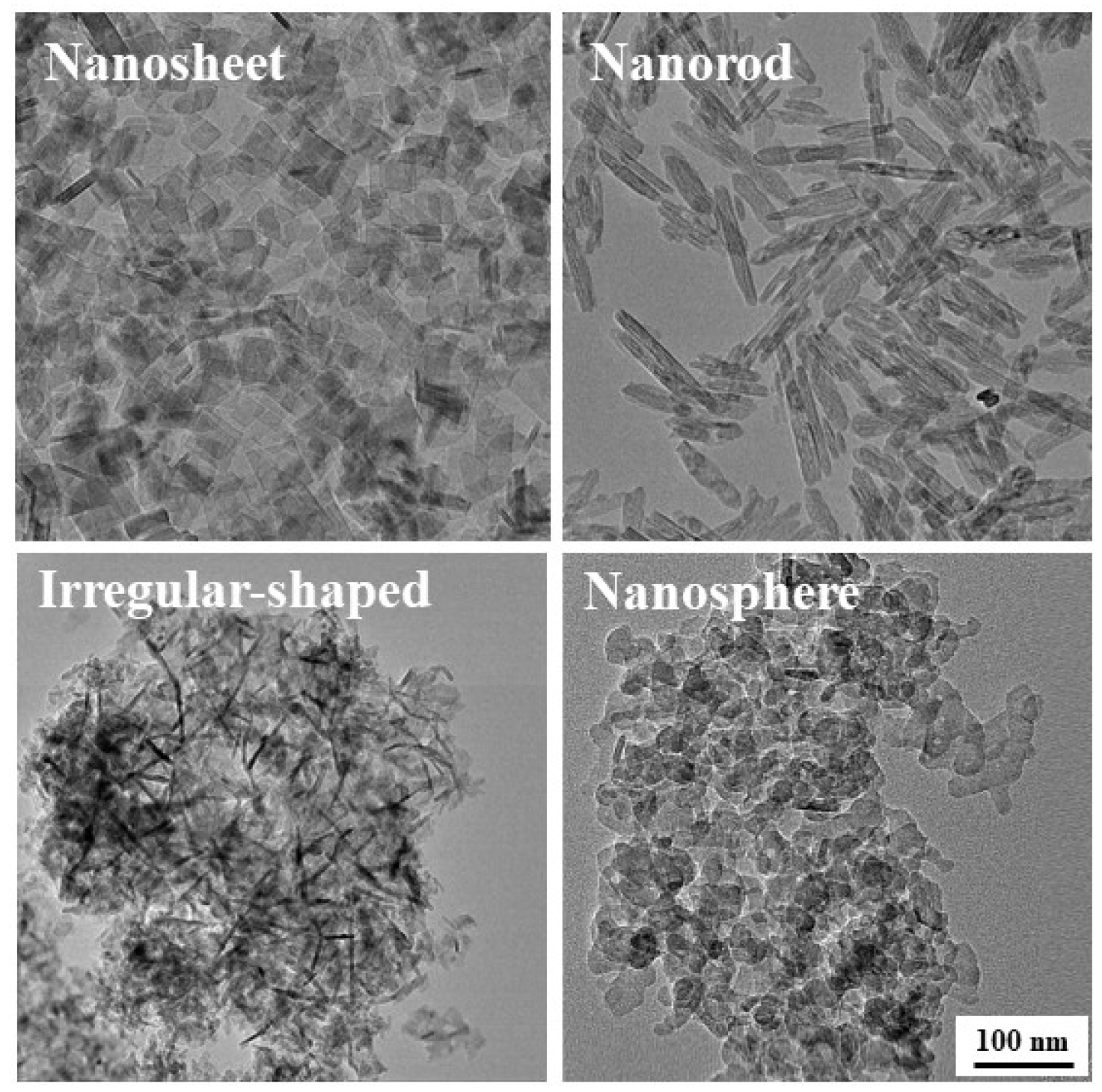
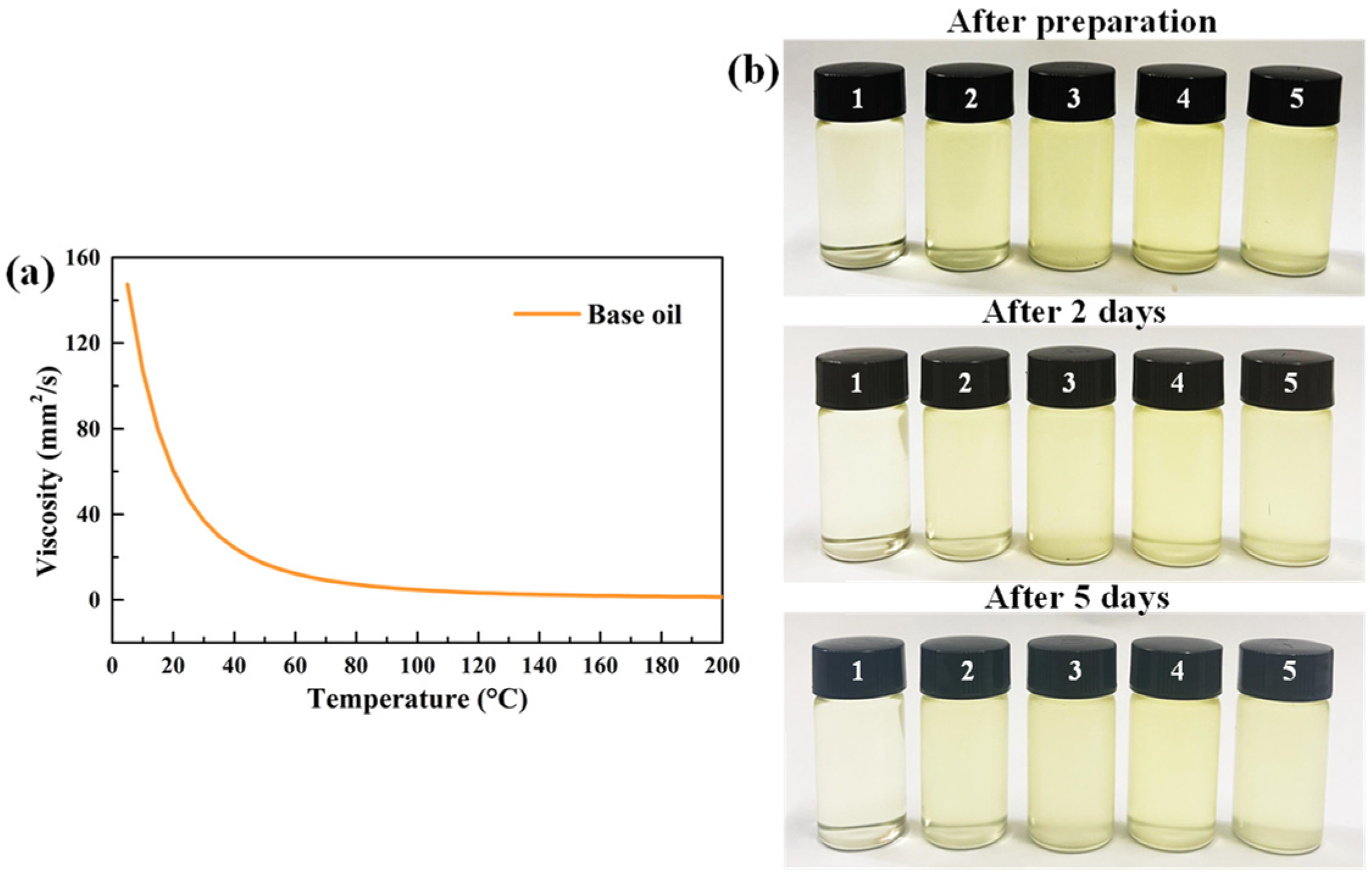
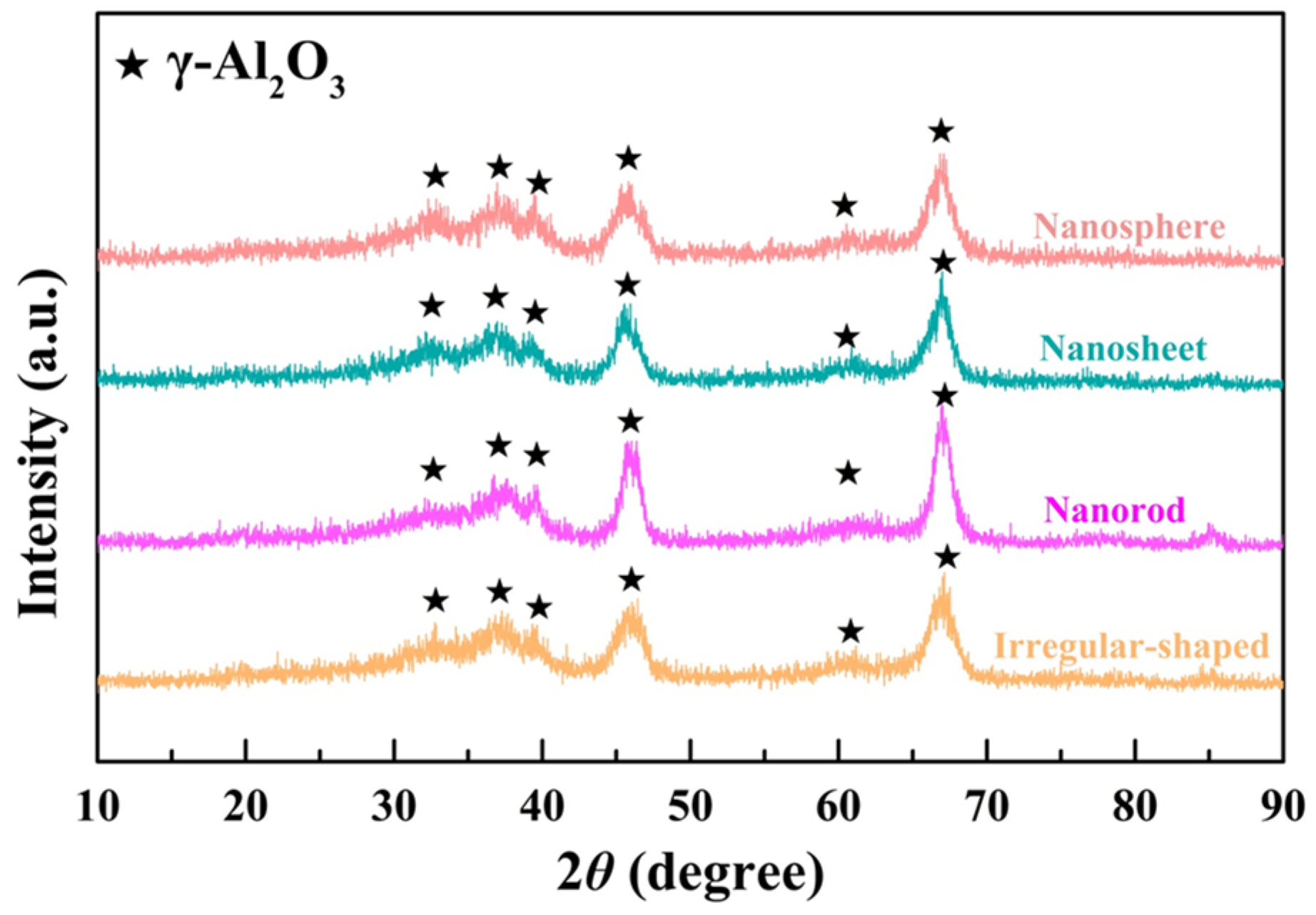


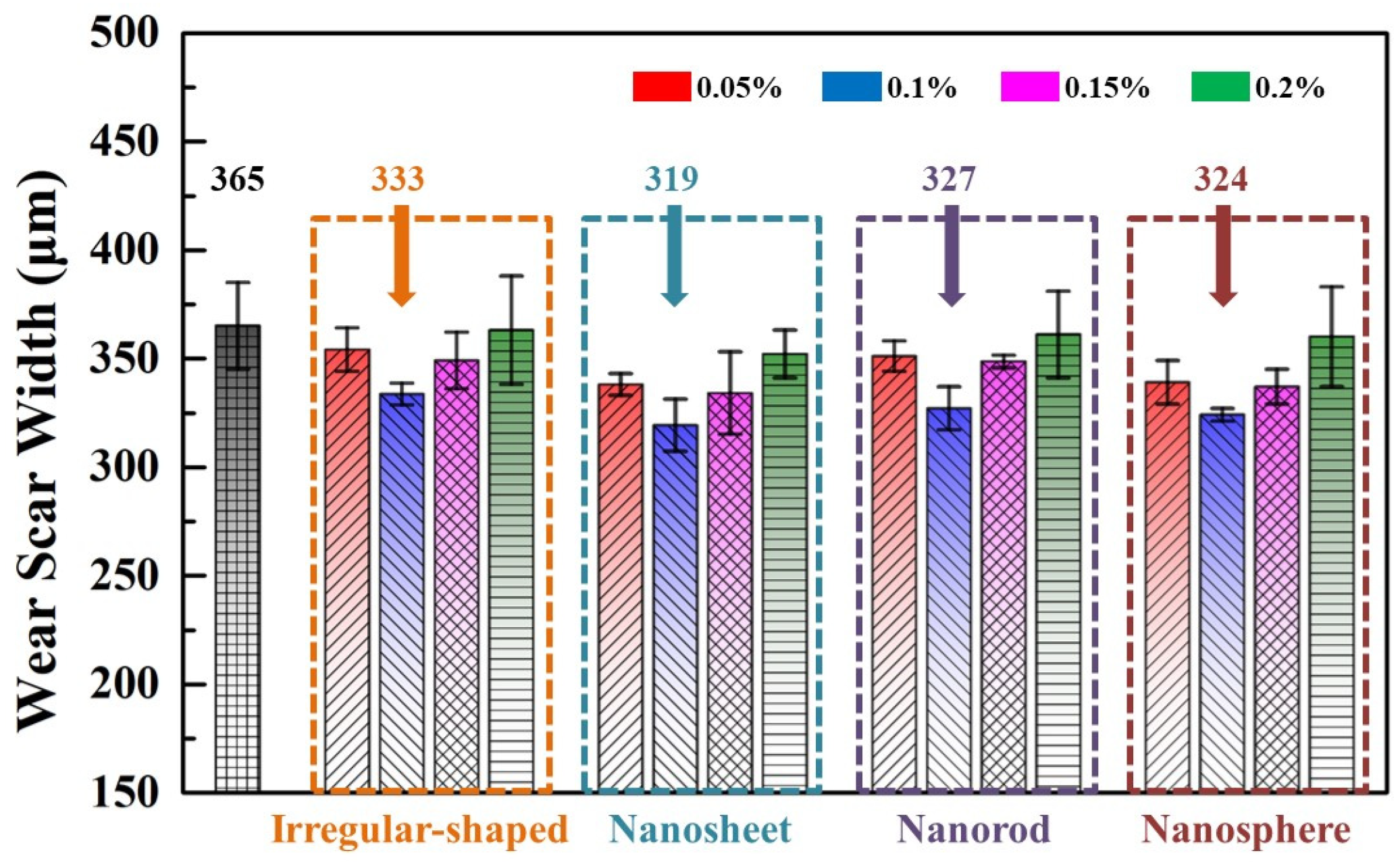
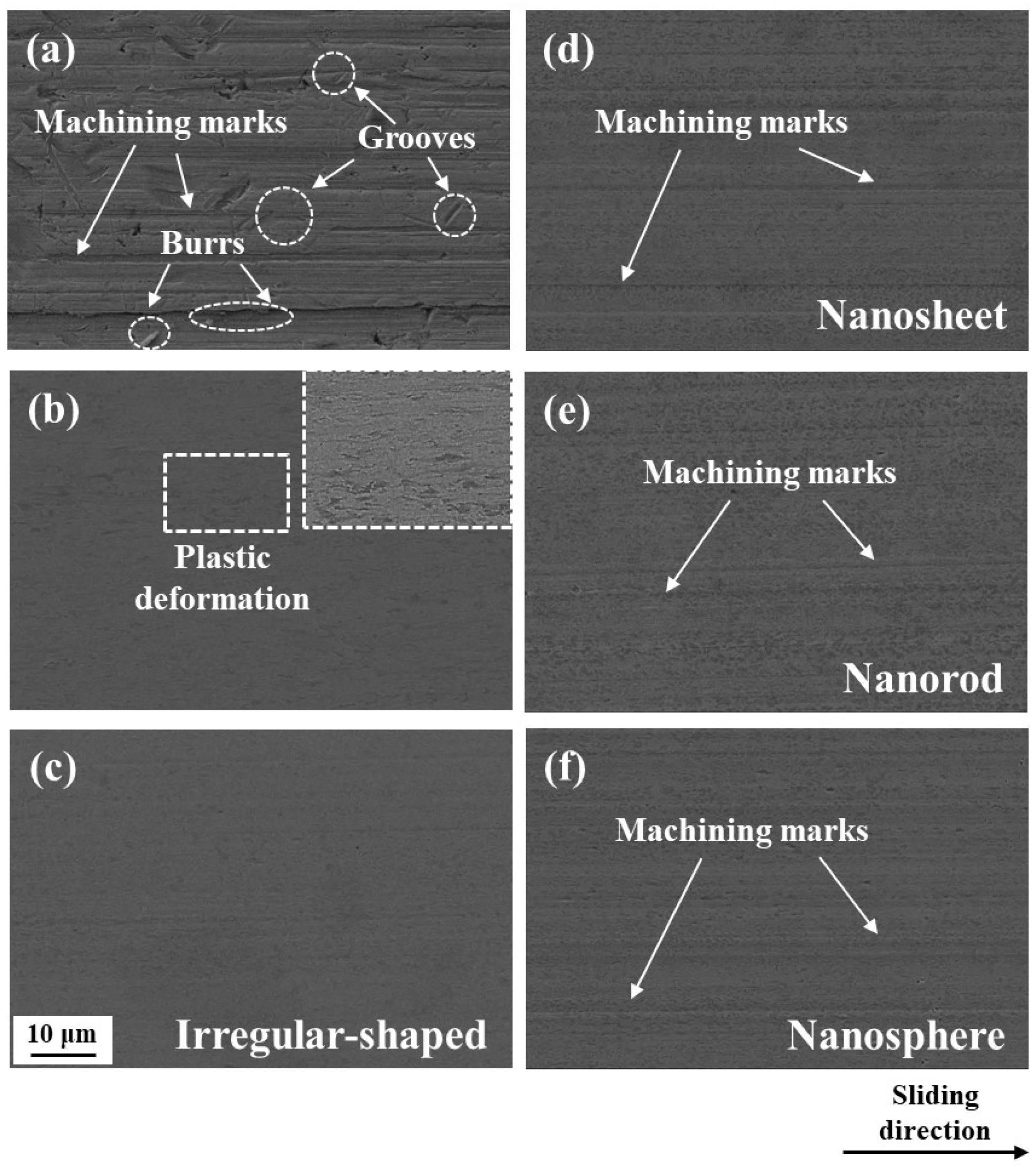
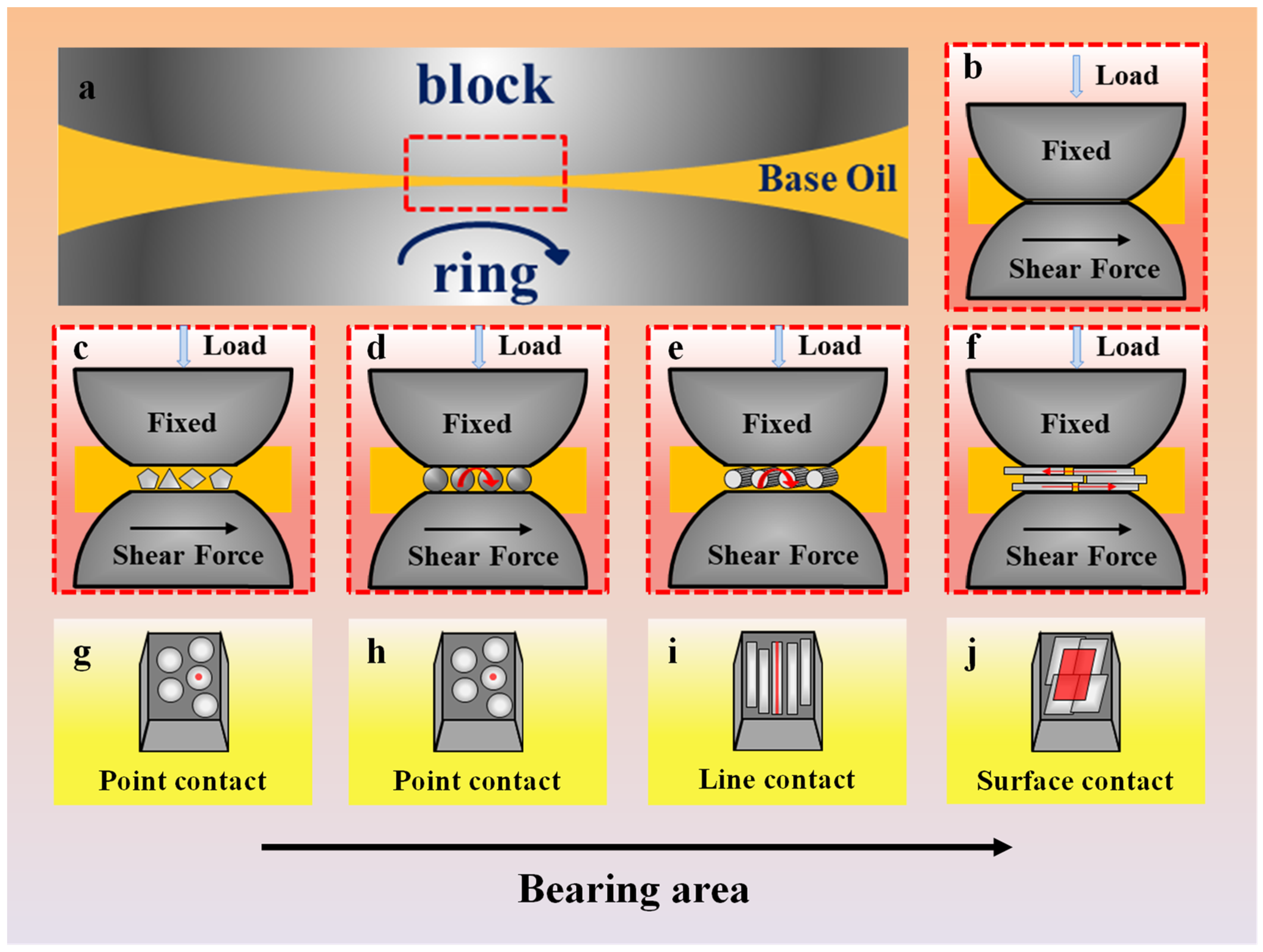
| Case | Parameters | Value |
|---|---|---|
| 1 | Normal load | 50 N |
| 2 | Test temperature | 200 °C |
| 3 | Rotational speed | 10 r/s |
| 4 | Test time | 45 min |
| 5 | Lubricant amount | 4 mL |
Disclaimer/Publisher’s Note: The statements, opinions and data contained in all publications are solely those of the individual author(s) and contributor(s) and not of MDPI and/or the editor(s). MDPI and/or the editor(s) disclaim responsibility for any injury to people or property resulting from any ideas, methods, instructions or products referred to in the content. |
© 2024 by the authors. Licensee MDPI, Basel, Switzerland. This article is an open access article distributed under the terms and conditions of the Creative Commons Attribution (CC BY) license (https://creativecommons.org/licenses/by/4.0/).
Share and Cite
Wang, Z.; Wang, J.; Wang, J.; Tian, H.; Zhang, B.; Grinkevych, K.; Xu, J. Tribological Properties of Nano-Scale Al2O3 Particles with Different Shapes as Lubricating Oil Additives. J. Mar. Sci. Eng. 2024, 12, 1069. https://doi.org/10.3390/jmse12071069
Wang Z, Wang J, Wang J, Tian H, Zhang B, Grinkevych K, Xu J. Tribological Properties of Nano-Scale Al2O3 Particles with Different Shapes as Lubricating Oil Additives. Journal of Marine Science and Engineering. 2024; 12(7):1069. https://doi.org/10.3390/jmse12071069
Chicago/Turabian StyleWang, Zichun, Jingsi Wang, Jiayuan Wang, Heyuan Tian, Boshen Zhang, Konstantin Grinkevych, and Jiujun Xu. 2024. "Tribological Properties of Nano-Scale Al2O3 Particles with Different Shapes as Lubricating Oil Additives" Journal of Marine Science and Engineering 12, no. 7: 1069. https://doi.org/10.3390/jmse12071069




